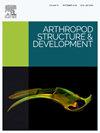Sternal glands in Strumigenys ants
IF 1.3
3区 农林科学
Q2 ENTOMOLOGY
引用次数: 0
Abstract
Strumigenys ants are characterized by an extraordinary developed exocrine system with 10 glands exclusively found in this genus. Making a survey of 18 species, we discovered two additional glands in workers and queens that are located underneath the anterior third of the 6th and 7th sternites. The epithelial glands are formed by cubic to cylindrical cells that have tortuous lateral cell membranes with interdigitations and apical septate junctions, smooth endoplasmic reticulum and apical microvilli. The glands occur in near proximity to the sting base and therefore may display fortifications to protect them against the sting movements during its extrusion and retraction. The external cuticle that covers the gland region displays small transverse grooves and transcuticular channels. The most developed glands were found in workers of the social parasite Strumigenys mutica, although the eventual link with social parasitism remains unclear. In workers of S. sauteri the glands are rudimentary or absent which may be related with prey capture in this species that occurs without use of the sting. Whereas sternal glands in other ants often produce trail pheromones, this role can be excluded in Strumigenys as trail following does not occur in this genus.

Strumigenys蚂蚁的胸腺
Strumigenys蚂蚁的特点是一个非常发达的外分泌系统,有10个腺体,只有在这个属中发现。通过对18个物种的调查,我们在工蚁和蚁后身上发现了两个额外的腺体,它们位于第6和第7胸骨前三分之一的下方。上皮腺由立方到圆柱形的细胞组成,这些细胞具有弯曲的外侧细胞膜,具有交错和顶端分隔连接,光滑的内质网和顶端微绒毛。腺体发生在刺基部附近,因此可能显示防御工事,以保护它们免受刺在挤压和收缩期间的运动。覆盖腺体区域的外角质层显示小的横向沟槽和经角质层的沟槽。最发达的腺体是在群居寄生虫Strumigenys mutica的工蜂中发现的,尽管与群居寄生的最终联系尚不清楚。在苏氏刺蝇的工蜂中,腺体是初级的或没有的,这可能与该物种在不使用刺的情况下捕获猎物有关。虽然其他蚂蚁的胸骨腺经常产生线索信息素,但在Strumigenys中可以排除这种作用,因为在该属中不发生线索跟踪。
本文章由计算机程序翻译,如有差异,请以英文原文为准。
求助全文
约1分钟内获得全文
求助全文
来源期刊
CiteScore
3.50
自引率
10.00%
发文量
54
审稿时长
60 days
期刊介绍:
Arthropod Structure & Development is a Journal of Arthropod Structural Biology, Development, and Functional Morphology; it considers manuscripts that deal with micro- and neuroanatomy, development, biomechanics, organogenesis in particular under comparative and evolutionary aspects but not merely taxonomic papers. The aim of the journal is to publish papers in the areas of functional and comparative anatomy and development, with an emphasis on the role of cellular organization in organ function. The journal will also publish papers on organogenisis, embryonic and postembryonic development, and organ or tissue regeneration and repair. Manuscripts dealing with comparative and evolutionary aspects of microanatomy and development are encouraged.

 求助内容:
求助内容: 应助结果提醒方式:
应助结果提醒方式:


